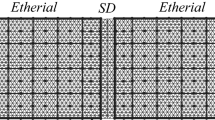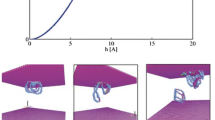Abstract
This contribution introduces an adaptively coupled finite element (FE)–molecular dynamics (MD) model based on the Quasicontinuum (QC) method. The idea for obtaining constitutive laws from the underlying lattice structure (local QC model) will be discussed in detail. The outline of the formulation for the quasi-static MD model (nonlocal QC model) will also be derived in the same mathematical structure. A new type of element is proposed to solve the boundary problems and to couple the FE and MD models. The interpolation techniques for the atomic stress and strain fields are introduced. A two-step adaptive mechanism is applied to the multiscale model, including the mesh refinement step for the FE model and the FE–MD conversion step. A 3D nanoindentation example is used for demonstrating accuracy and the efficiency of the coupled FE–MD model at the end.
Similar content being viewed by others
References
Ashby M, Jones D (1996) Engineering materials 1: an introduction to their properties & applications, 2nd edn. Butterworth-Heinemann, Oxford
Babuska I, Melenk J (1998) The partition of unity method. Int J Numer Methods Eng 40: 727–758
Born M, Huang K (1954) Dynamical theory of crystal lattices. Oxford University Press, Oxford
Cormier J, Rickman J, Delph T (2001) Stress calculation in atomistic simulations of perfect and imperfect solids. J Appl Phys 89: 99–104
Daw M, Baskes M (1984) Embedded-atom method: Derivation and application to impurities, surfaces, and other defects in metals. Phys Rev B 29: 6443–6453
de Graef M, McHenry M (2007) Structure of materials. Cambridge University Press, Cambridge
Dobson M, Elliott R, Luskin M, Tadmor E (2007) A multilattice quasicontinuum for phase transforming materials: Cascading cauchy born kinematics. J Comput Aided Mater Des 14: 219–237
Dobson M, Elliott R, Tadmor E (2006) A quasicontinuum for complex crystals. In: Proceedings of the Third International Conference on Multiscale Materials Modeling
Dupuy L, Tadmor E, Miller R, Phillips R (2005) Finite temperature quasicontinuum: molecular dynamics without all the atoms. Phys Rei Lett 95: 060202
Eidel B, Stukowski A (2009) A variational formulation of the quasicontinuum method based on energy sampling in clusters. J Mech Phys Solids 57: 87–108
Ercolesssi F, Adams J (1994) Interatomic potentials from first-principles calculations: the force-matching method. Europhys Lett 26: 583–588
Fago M, Hayes R, Carter E, Ortiz M (2004) Density-functional-theory-based local quasicontinuum method: prediction of dislocation nucleation. Phys Rei B 70: 100102(R)
Feyel F (2003) A multilevel finite element method (fe2) to describe the response of highly non-linear structures using generalized continua. Comput Methods Appl Mech Eng 192: 3233–3244
Fish J (2006) Bridging the scales in nano engineering and science. J Nanoparticle Res 8: 577–594
Fish J, Nuggehally M, Shephard M, Picu C, Badia S, Park M, Gunzburger M (2007) Concurrent atc coupling based on a blend of the continuum stress and the atomistic force. Comput Methods Appl Mech Eng 196: 4548–4560
Gnecco E, Meyer E (2007) Fundamentals of friction and wear on the nanoscale. Springer, Berlin
Gross D, Seelig T (2006) Fracture mechanics. Springer, Berlin
Hardy R (1982) Formulas for determing local properties in molecular-dynamics simulations: shock waves. J Chem Phys 76: 622–628
Holzapfel G (2000) Nonlinear solid mechanics: a continuum approach for engineering. Wiley, New York
Holzmann M, Man J, Vlach B (1992) Comparison of fracture toughness temperature curves determined at impact and rapid loading on small and large specimens. Mater Sci 28: 255–259
Jin J, Shevlin S, Guo Z (2008) Multiscale simulation of onset plasticity during nanoindentation of al(0 0 1) surface. Acta Mater 56: 4358–4368
Kamm G, Alers G (1964) Low-temperature elastic moduli of aluminium. J Appl Phys 35: 327–330
Kitamura T, Umeno Y, Tsuji N (2004) Analytical evaluation of unstable deformation criterion of atomic structure and its application to nanostructure. Comput Mater Sci 29: 499–510
Lennard-Jones J (1931) Cohesion. Proc Phys Soc 43: 461–482
Li J, Vliet K, Zhu T, Yip S, Suresh S (2002) Atomistic mechanisms governing elastic limit and incipient plasticity in crystals. Nature 418: 307–310
Liu X, Ercolessi F, Adams J (2004) Aluminium interatomic potential from density functional theory calculations with improved stacking fault energy. Model Simul Mater Sci Eng 12: 665–670
Lu G, Tadmor E, Kaxiras E (2006) From electrons to finite elements: a concurrent multiscale approach for metals. Phys Rev B 73: 024108
Luan B, Robbins M (2005) The breakdown of continuum models for mechanical contacts. Nat Lett 435: 929–932
Lutsko J (1988) Stress and elastic constants in anisotropic solids: molecular dynamics techniques. J Appl Phys 64: 1152–1154
Miller R, Tadmor E (2002) The quasicontinuum method: Overview, applications and current directions. J Comput Aided Mater Des 9: 203–239
Miller R, Tadmor E (2009) A unified framework and performance benchmark of fourteen multsicale/continuum coupling methods. Model Simul Mater Sci Eng 17: 1–51
Parvazinia M, Nassehi V, Wakeman R (2006) Multi-scale finite element modelling using bubble function method for a convection-diffusion problem. Chem Eng Sci 61: 2742–2751
Qu S, Shastry V, Curtin W, Miller R (2005) A finite-temperature dynamic coupled atomistic/discrete dislocation method. Model Simul Mater Sci Eng 13: 1101–1118
Rapaport D (2004) The art of molecular dynamics simulation, 2nd edn. Cambridge University Press, Cambridge
Rodney D, Phillips R (1999) Structure and strength of dislocation junctions: an atomic level analysis. Phys Rev Lett 82: 1704–1707
Schmidt A, Siebert K (2005) Design of adaptive finite element software. Springer, Berlin
Shenoy V, Miller R, Tadmor E, Phillips R, Ortiz M (1998) Quasicontinuum models of interfacial structure and deformation. Phys Rev Lett 80: 742–745
Shiari B, Miller R, Curtin W (2005) Coupled atomistic/discrete dislocation simulations of nanoindentation at finite temperature. J Eng Mater Technol 127: 358–368
Tadmor E, Miller R (2005) Handbook of materials modeling, part A:2. In: The theory and implementation of the quasicontinuum method. Springer, Netherlands, pp 663–682
Tadmor E, Ortiz M, Phillips R (1996) Quasicontinuum analysis of defects in solids. Philos Mag A 73: 1529–1563
Tadmor E, Phillips R (1996) Mixed atomistic and continuum models of deformation solids. Langmuir 12: 4529–4534
Wang C, Jian S, Jang J, Lai Y, Yang P (2008) Multiscale simulation of nanoindentation on ni(1 0 0) thin film. Appl Surf Sci 255: 3240–3250
Xiao S, Belytschko T (2004) A bridging domain method for coupling continua with molecular dynamics. Comput Methods Appl Mech Eng 193: 1645–1669
Yang C, Tartaglino U, Persson B (2006) A multiscale molecular dynamics approach to contact mechanics. Eur Phys J E Soft Matter Biol Phys 19: 47–58
Yonenaga I, Motoki K (2001) Yield strength and dislocation mobility in plastically deformed bulk single-crystal gan. J Appl Phys 90: 6539–6541
Zimmerman J, Webb E III, Hoyt J, Jones R, Klein P, Bammann D (2004) Calculation of stress in atomistic simulation. Model Simul Mater Sci Eng 12: S319–S332
Author information
Authors and Affiliations
Corresponding author
Rights and permissions
About this article
Cite this article
Shan, W., Nackenhorst, U. An adaptive FE–MD model coupling approach. Comput Mech 46, 577–596 (2010). https://doi.org/10.1007/s00466-010-0503-3
Received:
Accepted:
Published:
Issue Date:
DOI: https://doi.org/10.1007/s00466-010-0503-3




